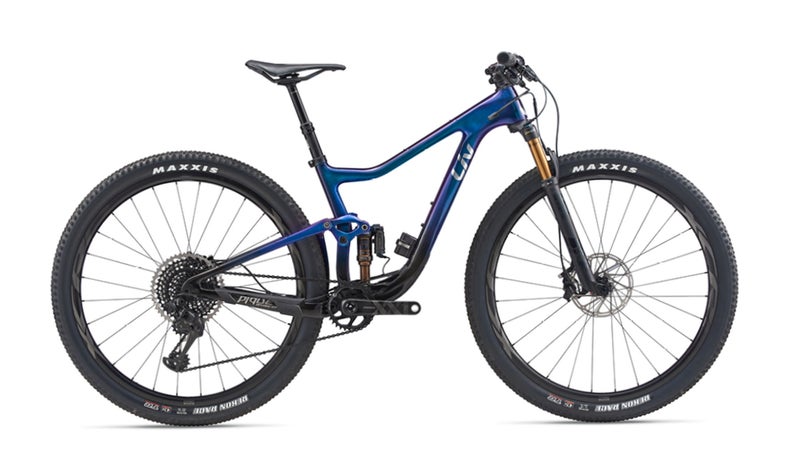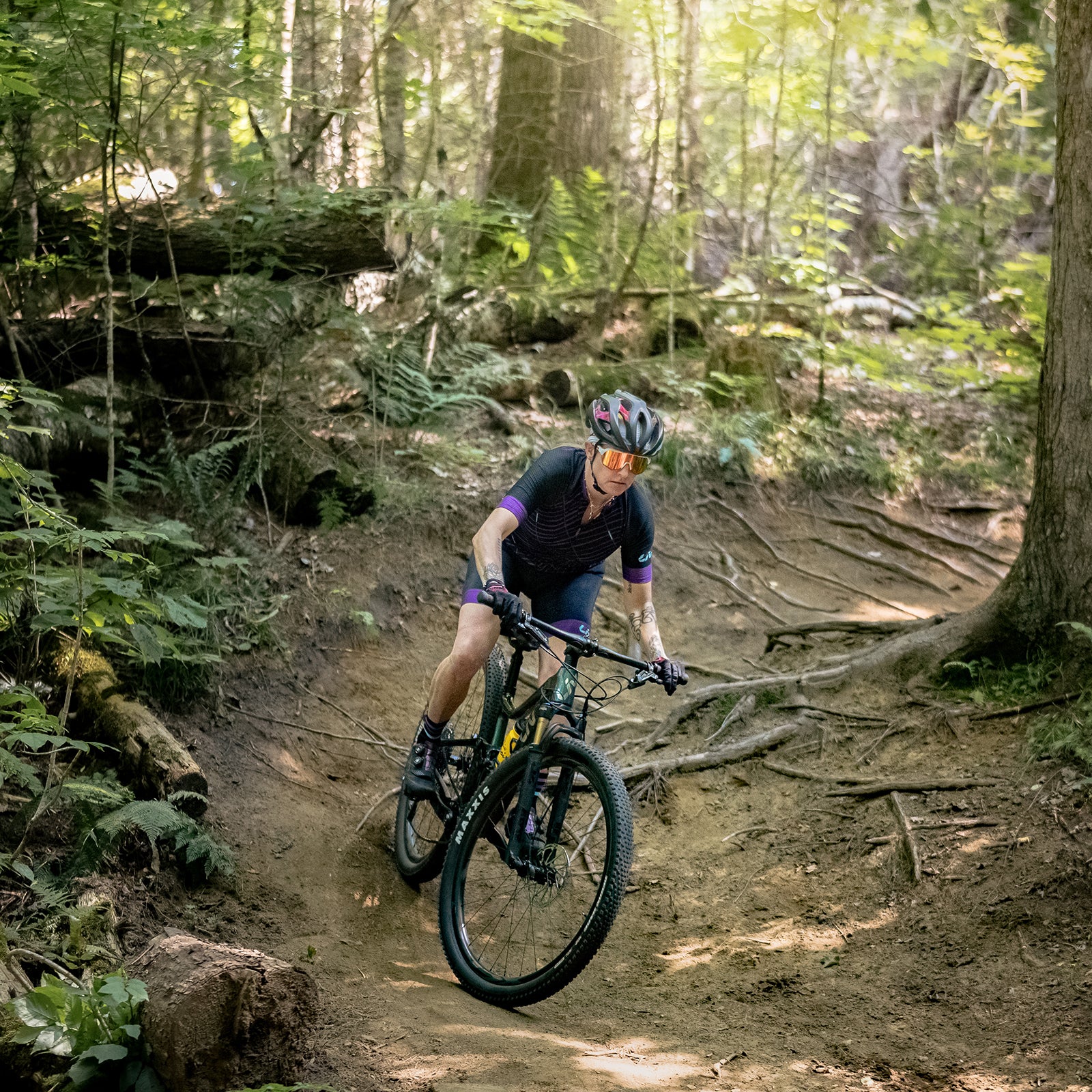One morning last month in East Burke, Vermont,╠řmechanics at Liv were polishing up a fleet of the most razzle-dazzle mountain bikes the company has ever offered. The full-carbon that I was about to test retails for a whopping $12,300ÔÇöquite a bit more than the accessibly priced models╠řthis company has become known for. ItÔÇÖs also,╠řunapologetically, a womenÔÇÖs bike, designed from anatomical and physiological data specific to women. So before I could throw a leg over LivÔÇÖs sparkling new rig, I first sat down to hear the case for womenÔÇÖs-specific bike design.
A brand video laid out the evidence. Using data from ╠ř(a global anthropometric database) and NASA, Liv has learned that women have narrower shoulders, shorter arms, and shorter crotch heights, among other differences. Those trends become more pronounced among shorter men and women,╠řmeaning that women are less likely to achieve an ideal fit on smaller-size╠řframes built for men. ░┬┤ă│ż▒▓ďÔÇÖs muscle activity also reveals distinctive patterns: ladies activate their rectus femoris (one of the thighÔÇÖs quad muscles) more than men, so LivÔÇÖs steeper seat-tube angles put the rider in a position to favor that muscle. Because womenÔÇÖs ratio of lower-body to upper-body strength is higher than menÔÇÖs, Liv adjusts the stiffness of its bikes accordingly,╠řmaking some regions╠ř(Liv declined to disclose specifics on which ones) softer and others more rigid╠řto compensate for womenÔÇÖs powerful pedal strokes.
ÔÇťWe build bikes from the ground up, using data points from women,ÔÇŁ says Cassondra Spring, LivÔÇÖs global marketing communications specialist. ÔÇťItÔÇÖs something weÔÇÖre really proud of. We think it sets us apart.ÔÇŁ That commitment to womenÔÇÖs bike design seems more distinctive every year.
Back in the late 1990s, Trek rolled out the first line of bikes built using╠řwomenÔÇÖs-specific design (WSD). These werenÔÇÖt just fitted with different saddles to accommodate womenÔÇÖs typically broader hips. Instead, womenÔÇÖs-specific geometries promised to cater to female proportions (which often mean longer legs and shorter torso lengths relative to overall height). More companies followed, until womenÔÇÖs bikes became a well-established category. Liv, a subsidiary of Giant, joined the party in 2008.
However, some brands never embraced the womenÔÇÖs-design trend. For example,╠řJuliana may be a womenÔÇÖs brand, but its bikesÔÇÖ geometries are identical to the menÔÇÖs versions made by Santa Cruz, JulianaÔÇÖs parent company.╠ř
And in recent years, many of the cycling brands that╠řtouted womenÔÇÖs bike design have been, well, backpedaling. In 2018, Trek announced that it would phase out its WSD models in favor of unisex geometries. In 2020, Specialized will discontinue its womenÔÇÖs models, and Yeti will no longer offer its Beti line of womenÔÇÖs mountain bikes.
Liv, meanwhile, remains committed to womenÔÇÖs design. ÔÇťWe donÔÇÖt just make a womenÔÇÖs bike,ÔÇŁ says Spring. ÔÇťWe make a lot of them.ÔÇŁ In fact, the $12,300 version of the Pique Advanced Pro 29 appeals to uncompromising experts seeking top technology. Many gear companies (not just bike brands) have long assumed that this kind of customer is exclusively male. But Liv is betting that womenÔÇösome of them, at leastÔÇöwill open their wallets for a brilliant mountain bike.

And╠řyes, the Pique Advanced Pro 29 is a marvelous bike. Top-end builds come with FoxÔÇÖs latest innovation, the╠ř, which electronically and automatically╠řadjusts the fork and shock settings to adapt to terrain changes within three╠řmilliseconds of sensing them,╠řmeaning the suspension optimization is practically immediate.
All versions of the bike (aluminum Pique 29 frames start at $2,050) overcome mostÔÇöand maybe allÔÇöof the challenges associated with fitting 29-inch wheels to small and extrasmall frames. IÔÇÖm five feet tall, and IÔÇÖve personally experienced those downsides: the╠ř29ers IÔÇÖve tested felt sluggish when I accelerated, and their long wheelbase lacked agility in tight corners. But Liv racer (who is also petite) wanted a 29er, so the companyÔÇÖs designers set out to solve the conundrum of big wheels on small bikes.
ÔÇťItÔÇÖs really hard,ÔÇŁ laughs Sophia Shih, LivÔÇÖs advanced engineer. She started with a computer simulation of an ideal╠řwoman-specific riding position.╠řThen, using more computer-aided engineering, Shih tweaked the frameÔÇÖs geometry and construction to preserve that ideal position on the bike.
The resulting frame has a very short rear center (the distance from the bottom bracket to the rear axle) for agility╠řand a superstiff bottom-bracket linkage for snappy acceleration. ÔÇťIt was a challenge to get it stiff enough,ÔÇŁ says Shih, who persisted in adjusting the carbon layups and frame angles until she achieved the target numbers that would yield the desired stiffness.
Then╠řLiv worked closely with Fox to tune the Pique 29ÔÇÖs suspension. During a week of riding in Sedona, Arizona, a large team of female testers rode prototypes of the aluminum Pique 29 and carbon Pique Advanced Pro. They delivered their feedback to on-site engineers from Fox, who incorporated tester responses into recalculations for the forks and shocks. Consumers still have to set their own sag and rebound based on their weight and ride preferences, but the womenÔÇÖs-specific tune aims to optimize the bikeÔÇÖs performance by calibrating the suspension components to the riderÔÇÖs anticipated inputs.
When it came time for me to ride the Pique Advanced Pro, the afternoon sun blazed above VermontÔÇÖs Kingdom Trails. But riding this bike felt effortless. The fit was perfect from the get-go, requiring no adjustments to the stem or cranks for me to feel at home on the extrasmall╠řsize. I appreciated the pedaling efficiency as soon as I started climbing: the bike accelerates with ego-stroking immediacy and seems to translate every watt of energy into forward propulsion. I loved its ability to zoom out of corners and thrust me up hillsÔÇöquite unlike what IÔÇÖve felt on other 29ers.
As expected, the big hoops smoothed out the roots I frequently encountered while riding among VermontÔÇÖs maples. But I also loved the bikeÔÇÖs surprising stability on ledgy descents. With 100 millimeters╠řof front and rear suspension, itÔÇÖs built for cross-country╠řtrails and races, yet I hardly felt pummeled by the occasional ruts, drops, and rock gardens I negotiated.
So do women need a womenÔÇÖs-specific bike? Maybe not. Many women have achieved good fit╠řand performance from mainline, gender-neutral bikes. But thereÔÇÖs nothing dumbed down about LivÔÇÖs 29er, which manages to fit an impressively wide range of womenÔÇöand that hardly deserves to go out of style.


